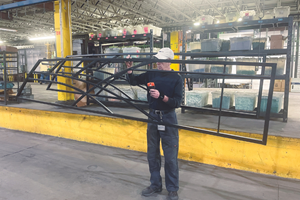Fisheyes and Galvanized Steel
I have a customer that is running electro-galvanneal through the powder coating process and we continually see “fish eyes” on all of the parts we do. Is there anything that can be done about it? Is there any difference between electro-galvanneal and “paint-lock” galvanneal?
Q. I have a customer that is running electro- galvanneal through the powder coating process and we continually see “fish eyes” on all of the parts we do. I know the electro-galvanneal is for wet paint, but should this be happening with the powdercoat? Is there anything that can be done about it? Is there any difference between electro-galvanneal and “paint-lock” galvanneal?
A. The term electro-galvanneal may be somewhat confusing. There are several different steel materials that use zinc to extend their corrosion resistance. Electro-galvanized and hot-dip galvanized steel use zinc as a coating over a steel surface to provide a protective sacrificial layer. Galvanneal is a further step in processing that uses heat to create a zinc-iron alloy on the steel surface.
First, a sheet of steel is dipped in a zinc bath at about 450°C. The steel then passes through furnaces to elevate the temperature to as much as 700°C. During this heating, iron atoms from the steel drift into the zinc coating to form a zinc-iron alloy that’s around 90% zinc and 10% iron.
Galvanneal is a gray metal with a hard surface. The consistency and quality of the galvannealing process depends on the uniformity and precision of the surface temperature during the manufacturing process. Galvanneal is typically preferred as a paintable surface. Paint loc or Paint Lock is a generic term for pre-phosphatized steel.
Fisheyes occur as a result of a contaminant on the surface that is water- resistant and to whichpowder will not adhere. It can be on the surface before coating or it can be in the coating material itself. The molten powder coating “crawls” around the contamination during the cure cycle and forms a round defect that usually includes a small spot or dome in the center. The fact that you see this on galvanized or galvanneal would not likely be because of the metal itself. Fisheyes indicate that there is some contaminant on the substrate and the preparation of the substrate is not sufficient to remove it.
Electro-galvanized steel is frequently powder coated with success, and so is galvanneal. But if there is oil on the surface that the washer cannot remove, or if there is silicone on the surface resulting from some other contaminant, you will have craters. Fisheyes are not easy to eliminate, so check every possible source in the building. Sweeping compounds, lubricants and die or mold release products are some common sources. Isolate prrducts and processes to see if you can eliminate the problem.
One question: Are you sure that the defect you see is a fisheye? A fisheye is a very distinctive defect that often leaves a crater that exposes the steel. Could your defect be out-gassing or pin-holing from some other cause (other than a silicone or similar contaminant)? Out-gassing is the release of trapped air or gases from the substrate during the cure process. It produces small bumps or depressions in the film that appear as craters or bumps in the film. It can be caused in galvanized material due to porosity in the zinc surface, or it can occur in a sharp bend in the steel. Pin-holing will form craters in the coating from surface contamination or moisture. Try to come up with another step in metal prep that will remove all surface contamination. Abrasion of the surface with a sanding operation or blasting is an example of a process that will remove stubborn contamination. Also, check the reclaimed powder to make sure that it is not contaminated. Spray some on a panel outside your plant and see if the problem occurs.
Related Content
Powder Coating 4.0: Smarter, Faster, More Efficient and Connected
New tools reduce cost and waste, lower manufacturing footprint of powder coating operations.
Read MoreTTX’s Automated Conveyor Carrier System Offers Wireless, Flexible Operation
ACC system designed for reliable, consistent point-to-point movement of everything from small to heavy parts.
Read MoreCuring Oven Basics
Simply heating up the substrate does not cure the coating. There are many variables to consider when choosing the best cure oven for your application...
Read MorePowder Coating Overcomes Post Forming
Six Sigma methodology, open communication, and collaboration produce results for leading boat manufacturer.
Read MoreRead Next
Education Bringing Cleaning to Machining
Debuting new speakers and cleaning technology content during this half-day workshop co-located with IMTS 2024.
Read MoreEpisode 45: An Interview with Chandler Mancuso, MacDermid Envio Solutions
Chandler Mancuso, technical director with MacDermid Envio discusses updating your wastewater treatment system and implementing materials recycling solutions to increase efficiencies, control costs and reduce environmental impact.
Read MoreA ‘Clean’ Agenda Offers Unique Presentations in Chicago
The 2024 Parts Cleaning Conference, co-located with the International Manufacturing Technology Show, includes presentations by several speakers who are new to the conference and topics that have not been covered in past editions of this event.
Read More












.jpg;maxWidth=300;quality=90)












